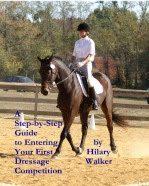 |
| I'm trying my hardest, honest! |
This is the third in a series of articles about implementing the suggestions in 4 Steps For Overcoming Your Horse’s Fear of Other Horses which I originally wrote for ezinearticles.com.
In the previous article I'd ended the training session with the scary horse trotting towards Cruz while he was on the inside track.
It was now time to take Cruz on the outside track, where he easily feels trapped.
A Bold Plan
Mindful that I increase Cruz’s anxiety by anticipating his, I decided to get more courageous in this next session. I wanted to learn just how much braver my horse and I had become after the exercises we’d already carried out.
When my friends - Julie, on ‘scary’ Cayenne, and Kelli, on friendly Pippi - entered the arena I told them: “Let’s just pretend Cruz has no problems, and ride around each other like normal horsewomen!”
Acting Normally
And that’s just what we did. We rode around like sensible riders, trotting and cantering towards each other on both the inside and outside tracks, following ring etiquette.
Cruz didn’t bat an eyelid! He’d become so used to working with these horses that even when friendly Pippi nearly ran into him, he wasn’t bothered. I’m not sure how he'd have reacted if ‘scary’ Cayenne had done that, but I was thrilled he stayed so calm when the hotter chestnut came towards him in every gait.
This was a major breakthrough! And just in time, too, as I had an upcoming competition on the weekend where I would have to warm up with other horses.
Showtime!
This particular show venue was perfect for our stage of ‘fear training.’ The warm-up area is very large, and familiar to Cruz.
Although there were only three other horses in there with us, one of them was a youngster and not totally under his rider’s control. So I was glad of the space to get out of his way!
Unlike previous times when I’ve tended to ‘hope for the best’ and not take charge of my horse, I was careful to ‘ride every stride’ in that warm-up. I let Cruz know that I was in command, and would keep him safe. “Just pay attention to me, and you’ll be fine.”
I was proud of him. One horse was performing lateral work, and moving sideways into our line of travel. I quietly turned Cruz away from the ‘threat’ and continued working him. Even when a horse was cantering towards him on a circle, and appeared ready to collide with our canter circle, Cruz kept his cool.
Yet another horse was coming into the warm-up. Since it was nearly my ride time, I decided to take Cruz out now and cash in on his calmness. It was making me feel calm, too, and I wanted to keep it that way.
Entering the Ring
The judge was having a short break. Just as I was about to go in and settle Cruz down before she returned, the rider of the hot young horse came out and asked to join us in the ring for a while.
She obviously thought my amazingly calm Cruz would be a soothing influence! I felt a heel, but had to say ‘no.’ I explained why, and she understood perfectly. Later when she rode her test her horse bucked several times and I knew I’d made a good decision.
Our two tests had some 7s and 8s mixed in with our not-so-good movements. We got 63% in our second showing, and won both Second Level classes. Don't tell anyone that we were the only partnership riding in them! But it was nice to have two blue ribbons (however dubiously come by) to celebrate our successful return to a warm-up arena.
It was an important first step in Cruz’s rehabilitation.
Coming Up
I have another show this weekend, after a two week break and a hurricane. However, the warm-up will be smaller and more crowded, and it may be too soon for Cruz to go in there. I will ride him at the venue on the day before, and see how he copes with the other horses before I decide whether to try the warm-up on the day.
I’ll be reporting back!






